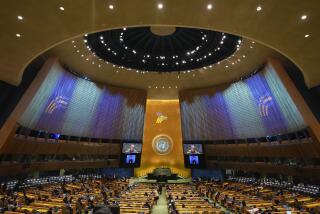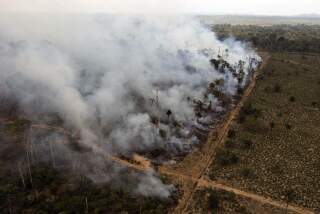46 Nations Agree on Pact to Protect Ozone Layer
Representatives of 46 nations adopted a landmark treaty in Montreal on Wednesday that will lead to a 50% reduction in use of ozone-depleting chlorofluorocarbons by the end of the century. But despite its historic significance, the treaty’s practical effects are likely to leave few people satisfied.
Manufacturers say that the treaty will cause a rise in the cost of CFCs, as the chemicals are called; in turn, that is likely to drive up the prices of consumer goods such as refrigerators and computers. An industry group has estimated that it will cost the United States at least $1 billion by the end of the century.
Scientists and environmental groups say the pact doesn’t go nearly far enough--in part because the treaty does not place any limits on Third World countries, where the use of chlorofluorocarbons is increasing.
“The treaty is an important first step because it is a precedent for future action, but it is really only a half step in controlling the ozone problem,” said David Doniger of the Washington-based Natural Resources Defense Council.
CFCs are prized by industry because they do not react with any chemicals in the environment and they are nontoxic. They are widely used in refrigerators and air conditioners, as blowing agents for insulating foams and as a cleaning agent in the electronics industry. More than one million tons of the chemicals are produced worldwide each year.
But their inertness creates a danger. The chemicals remain in the atmosphere for decades and slowly rise to the stratosphere, the segment of the atmosphere extending from nine to 30 miles above the Earth’s surface. There, sunlight breaks them apart, creating highly reactive chlorine atoms that destroy large amounts of ozone.
Ozone, a pollutant at ground level, is a protector in the stratosphere. Produced from oxygen by sunlight, it screens out more than 99% of the sun’s harmful ultraviolet radiation. But every 1% decrease in ozone allows 2% more ultraviolet to reach the ground. Many scientists believe there has already been at least a 3% reduction in the ozone layer.
For every 1% increase in ultraviolet, scientists say, there will be as many as 30,000 extra cases of skin cancer in the United States alone. Increased ultraviolet radiation can also have deleterious effects on aquatic organisms that live near the surface, on agricultural crops and on the climate.
Scientists have been debating since 1972 whether CFCs damage the ozone layer, but there now seems little doubt that they do. The clincher was the discovery three years ago of a large “hole” in the ozone layer over Antarctica, according to chemist F. Sherwood Rowland of the University of California, Irvine.
The hole, a 40% decrease in ozone over an area the size of the United States, occurs every spring, and most scientists believe it is caused by CFCs. “The hole changed everything,” Rowland said. “It got the governments to believe there is a problem.”
The treaty adopted Wednesday calls for a freeze in CFC consumption at 1986 levels beginning July 1, 1990. The United States, Japan and the nations of the European Communities were among those that signed the treaty Wednesday.
The freeze would be followed by a 20% reduction in consumption by June 30, 1994, and another 30% reduction by June 30, 1999.
Lee Thomas, administrator of the U.S. Environmental Protection Agency, said that “it feels great” to have the pact signed--even though the United States had requested a 95% reduction by the end of the century.
But there are several loopholes. Developing countries, such as China, India and most nations in South America and Africa, are exempted for 10 years, and the Soviet Union will be permitted to complete CFC production plants that are under construction. The Soviet Union has said it intends also to sign the treaty. India was not at the conference, and China has not yet signed.
Industrialized countries will be able to increase CFC production by 15% as long as they export to developing countries.
“The net effect is that it will really be only a 35% reduction,” said Doniger of Natural Resources Defense Council.
Many scientists think more drastic action is necessary. “We have to go for a 95% cutback and soon,” said Rowland. “Even if we stopped all CFC release now, the ozone-depletion would get worse for 20 years. Forty percent of the CFC that is in the atmosphere now will still be there in the year 2100.”
Most scientists were pleased that the treaty has provisions for revising the cutback levels as new evidence develops. “ I think that in the near future we’ll have a stronger case for much more severe reductions,” said chemist Mario Molina of the Jet Propulsion Laboratory in Pasadena.
But a spokeswoman for the Du Pont Co. of Wilmington, Del., which makes nearly 25% of the world’s CFCs, said there is no need for treaty-imposed cutbacks because there is “no imminent hazard to humans or the environment.” Cathy Forte said the company has already spent $15 million looking for alternatives, “but there is a lot of work left.”
Forte said it will be five to seven years before the company can begin producing alternatives, and that they will cost two to five times as much as CFCs. An industry trade group, the Alliance for Responsible CFC Policy, says that the cost to the United States of a freeze alone would total $1 billion between 1988 and 2000.
More to Read
Sign up for Essential California
The most important California stories and recommendations in your inbox every morning.
You may occasionally receive promotional content from the Los Angeles Times.










